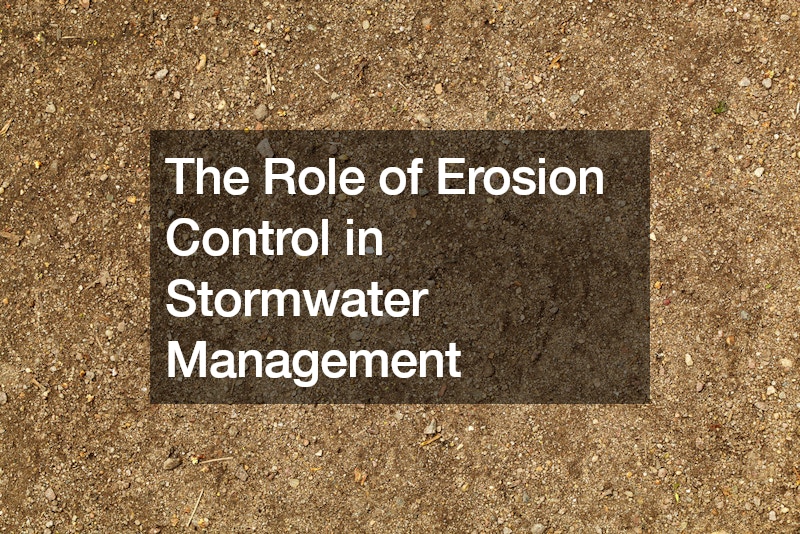
The Role of Erosion Control in Stormwater Management

Stormwater management is a critical aspect of urban planning and environmental conservation. As cities expand and development increases, the challenges of managing stormwater runoff become more pronounced. One of the key elements in mitigating the adverse effects of stormwater runoff is erosion control.
A Key Aspect of Civil Engineering
Erosion control is indeed a significant component of civil engineering. Civil engineers are responsible for designing, implementing, and managing infrastructure projects that include soil conservation measures.
Erosion prevention is integral to many civil engineering projects, particularly those involving the development of transportation systems, water resource management, and environmental conservation.
Civil engineers utilize various erosion prevention techniques and Best Management Practices (BMPs) to prevent soil erosion, stabilize slopes, and protect natural ecosystems. These techniques may include the installation of erosion control structures such as retaining walls, rock berms, and sediment traps, as well as the implementation of erosion mitigation measures such as vegetative stabilization, bioengineering, and land stabilization blankets.
Furthermore, civil engineers often work closely with environmental scientists, hydrologists, and landscape architects to develop comprehensive erosion control plans that address the specific needs and challenges of a project site. By integrating soil stabilization into the overall design and construction process, civil engineers help ensure the long-term sustainability and resilience of infrastructure projects while minimizing the impact on the environment.
The Basics of Erosion Control
Erosion control plays a vital role in preventing soil detachment and reducing the transport of sediment-laden runoff into storm drains and natural waterways. The process of erosion occurs when raindrops impact the soil surface, displacing tiny soil particles. These particles, once dislodged, can be easily transported by runoff, leading to soil erosion and sedimentation in water bodies.
Erosion Prevention Best Management Practices
To address erosion effectively, various erosion control Best Management Practices (BMPs) are employed. These BMPs aim to stabilize soil surfaces, prevent soil loss, and promote vegetation growth, ultimately reducing the risk of erosion and sedimentation.
One commonly used soil conservation BMP is the installation of fiber mats or geotextiles on exposed slopes. These mats, made of biodegradable materials such as straw or jute, are placed directly on the soil surface to hold the soil in place and promote the establishment of vegetation. By reducing runoff velocity and providing a protective cover, fiber mats help prevent soil erosion and promote soil stabilization.
Hydro mulch is another soil stabilization technique that involves spraying a mixture of natural fibers and water onto the soil surface. This temporary protective layer helps prevent soil erosion by providing a barrier against rainfall impact and promoting seed germination. However, hydro mulch requires specialized equipment for application and may need multiple applications to be effective.
Permanent Erosion Control Structures
In addition to temporary erosion control measures, permanent erosion control structures such as rock berms and retaining walls are used to stabilize slopes and prevent soil movement. Rock berms, constructed along slopes, trap sediment-laden runoff and prevent it from entering storm drains. Retaining walls, on the other hand, disrupt the downward movement of soil and retain sediment behind them, allowing water to seep through and filter out sediment.
Vegetation and Erosion Control
Vegetation plays a crucial role in soil conservation and is often considered nature’s finest land stabilization BMP. Established vegetation, with its extensive root systems, helps stabilize soil, reduce surface runoff, and prevent erosion. By absorbing water and holding soil particles in place, vegetation acts as a natural barrier against erosion and sedimentation.
The Impact of Chosen Mediation Strategies
When implementing erosion control measures, it is essential to consider their effectiveness in combination with sediment control BMPs. While soil conservation BMPs aim to prevent soil detachment, sediment control BMPs trap sediment that has already been displaced. By using both types of BMPs together, stormwater managers can ensure comprehensive protection against erosion and sedimentation.
Routine maintenance is also crucial for the effectiveness of soil conservation measures. Inspecting erosion control structures regularly and replacing worn-out materials helps maintain their integrity and effectiveness. Additionally, vegetation must be monitored and managed to ensure proper growth and coverage, enhancing its erosion prevention capabilities.
In conclusion, erosion control plays a fundamental role in effective stormwater management. By preventing soil erosion and reducing sedimentation, soil conservation BMPs help protect water quality, preserve natural habitats, and mitigate the adverse effects of stormwater runoff. Incorporating erosion prevention measures into stormwater management plans is essential for creating resilient and sustainable urban environments. Through careful planning, implementation, and maintenance of soil conservation BMPs, communities can effectively manage stormwater and safeguard their water resources for future generations.
.






